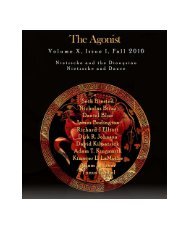Volume XII, Issue II, Spring 2019
You also want an ePaper? Increase the reach of your titles
YUMPU automatically turns print PDFs into web optimized ePapers that Google loves.
THE AGONIST<br />
calculations because a free particle does not interact), and something stable like<br />
the Parmenidean “being” are only chimeras.<br />
The river image, or metaphor, provides an argument against time machines.<br />
First of all, time machines, especially travels into the past, assume full processes<br />
of individuation because human travelers are conceived of as isolated, static<br />
beings, and detached “things” from becoming, from the universal flux, and from<br />
a milieu. Supposedly, the traveler through a CTC would return to another point<br />
over the river, interacting with another historical time and context, or another milieu<br />
as Simondon called. But in the river image, to abandon becoming and to travel<br />
into the past are impossible. The belief in some sort of complete individuation—<br />
provided by an interpretation of individuation as non-process, supposedly<br />
generated by the principle of individuation—leads to the belief in humans as<br />
something detached from becoming, or from some sort of context. The river<br />
picture, in turn, and essentially the becoming perspective reveal such a<br />
hypothetical travel as science fiction because the full individual—as a “free<br />
particle” 26 —and the Parmenidean concept of being are fable. The individual is<br />
not an aeterna veritas (eternal truth), is not apart from the universal flux, and,<br />
according to Nietzsche, this is a common error in philosophy:<br />
All philosophers have the common failing of starting out from man as he is now<br />
and thinking they can reach their goal through an analysis of him. They<br />
involuntarily think of “man” as an aeterna veritas, as something that remains<br />
constant in the midst of all flux, as a sure measure of things (HH 2).<br />
The pictorial argument presented in this article—the becoming point of<br />
view—does not deny time dilation (or different elapsed times) described by both<br />
special relativity and general relativity. 27 Such as on the ordinary river, flux in<br />
Heraclitus' river is not invariant. In a real river, the fluid velocity depends on the<br />
position and depth. A mass or volume of water (an “individual” or “being” in this<br />
metaphor) will have different velocities if its position is close or not to the margin,<br />
or at a great depth. Different elapsed times given by Lorentz's transformations in<br />
26 This is another metaphor. A “real” traveler through a CTC would experience tidal<br />
forces during a hypothetical time travel. The term “free particle” here indicates only an<br />
isolated individual from any context.<br />
27 In special relativity, time dilation is given by the relative motion of observers. On the<br />
other hand, in general relativity, time dilation is given by the gravitational redshift, which<br />
is generated by variations in the gravitational field and provides the GPS (Global<br />
Positioning System) technology.<br />
36









